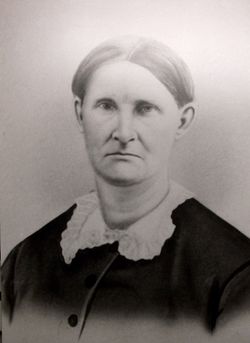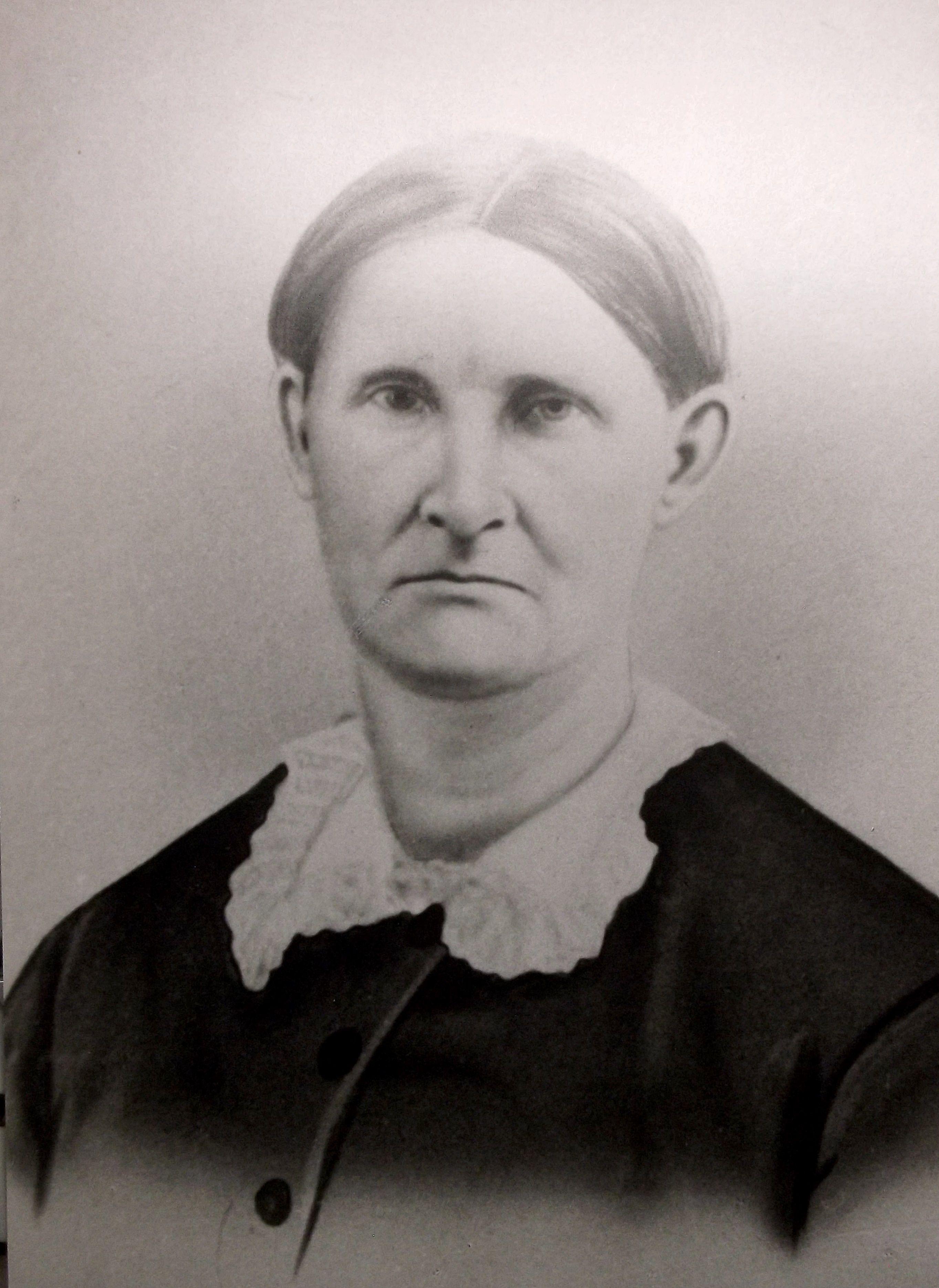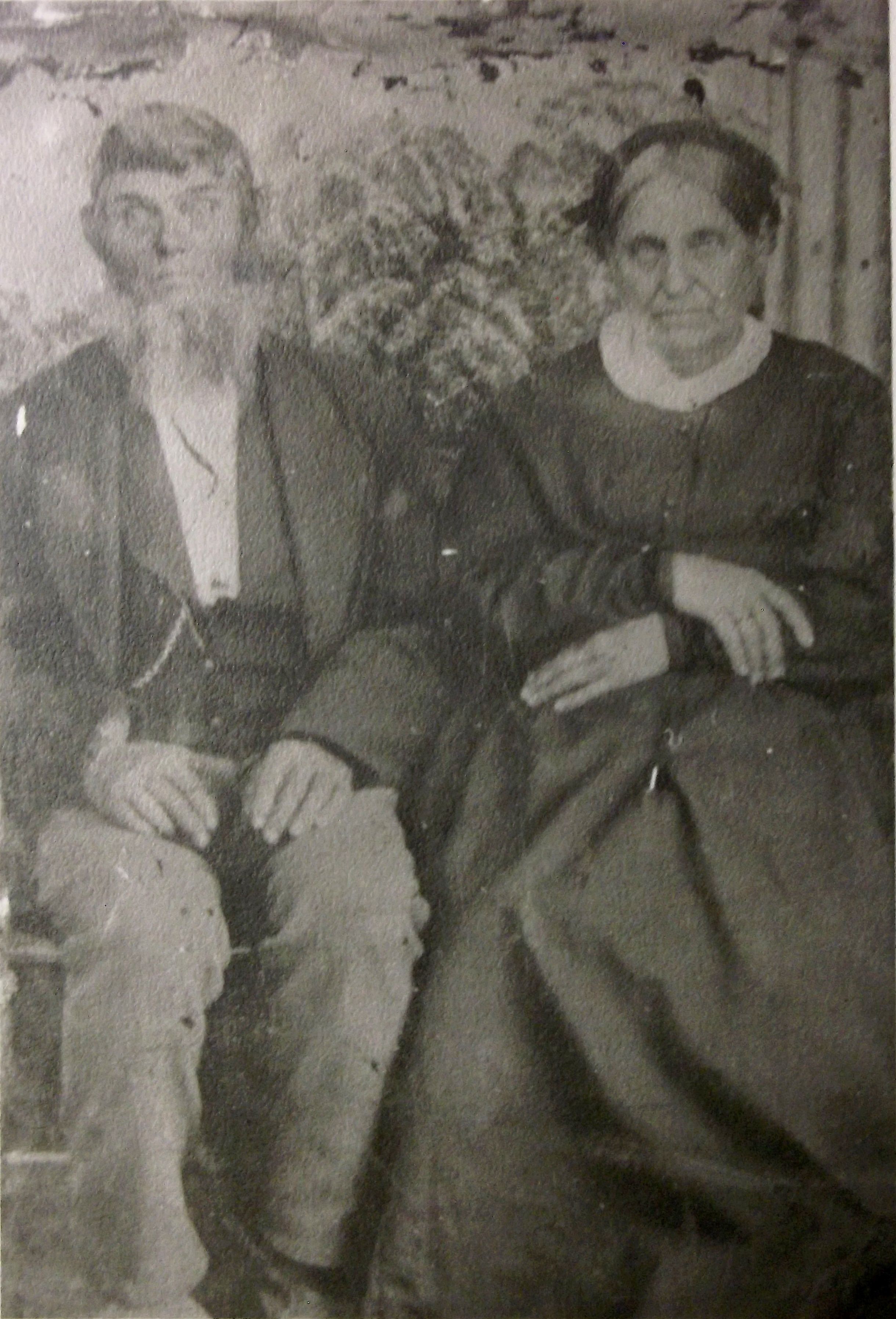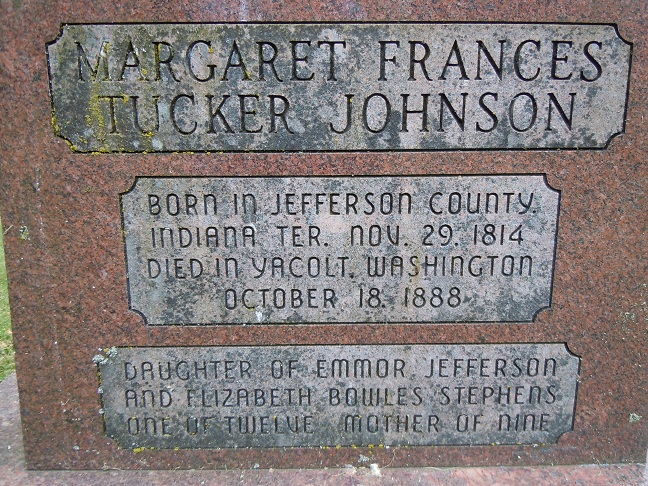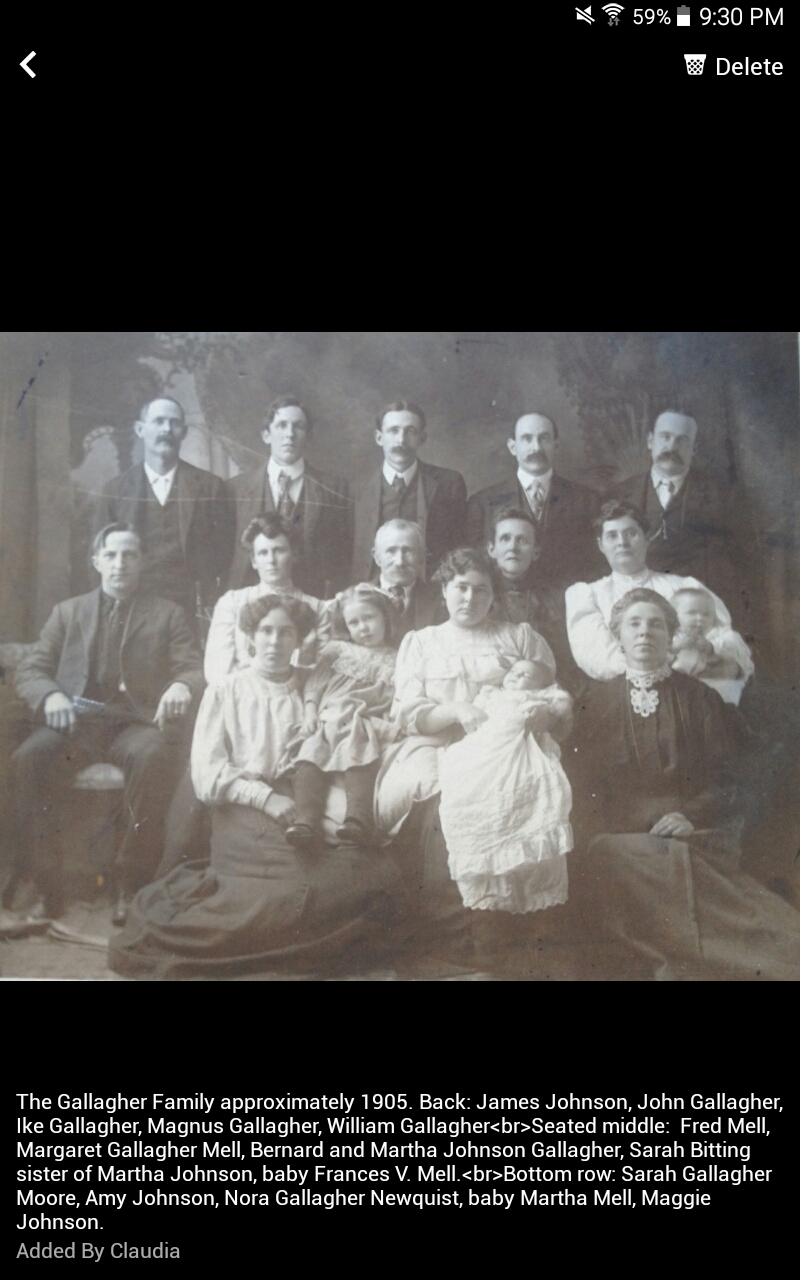Margaret Stephens was reared near Madison, Indiana, and later lived with family members in Hancock County, Illinois. On June 12, 1834, she married Benjamin Franklin Tucker, a farmer and teacher, at Carthage, Hancock County, Illinois. During the early years of their marriage the couple lived in Burlington, Iowa, but about 1841 they settled on a homestead in Washington Township, Washington County, Iowa. During this time Benjamin began a brief career as an educator, dividing his time between the rural schools in Washington County's sparsely populated townships. According to family tradition, he was ambushed and murdered by a hostile band of Indians while traveling to one of his schools. Margaret and Benjamin Tucker had three known children.
On August 24, 1845, in Crawford Township, Washington County, Iowa, Margaret began a 39-year marriage with Samuel Johnson, a native of the Buckeye State whose forebears had come to the American Colonies in pre-Revolutionary War times. Samuel's father was a New Jersey native who had grown to adulthood in Washington County, Pennsylvania, and his mother, a scion of one of the old families of Cape May, New Jersey, had been reared from early childhood in Allegheny County, Pennsylvania. Soon after the fertile lands in the Western Reserve were opened to settlement, Samuel's parents joined the westward migration and became substantial agriculturists in Ashland and Washington Counties, Ohio. As a lad in Ohio, Samuel took up the plow alongside his father and brothers. Though farming remained his primary occupation throughout his adult life, Samuel also held a preaching certificate from the Baptist church and was active in missionary work for many years. The Johnsons had six children, and spent the first 26 years of their marriage on the old Benjamin Tucker homestead in Crawford Township, Washington County, Iowa.
In the early 1870's Samuel accepted a missionary assignment as a circuit riding preacher to the large and widely scattered Baptist community of southwest Washington Territory. In February 1871, after selling their farm, the Johnsons set out for the Oregon Country. By one account not verified the couple took a railroad route east to New York City, and from there booked passage on a sailing ship bound for the Isthmus of Panama, which they crossed on foot, boarding a ship on the Pacific Ocean side for the remaining sea voyage to Portland. In other places it is recorded that the Johnsons took an overland route that placed them in Portland in the fall of 1871. In any event, once in Portland the family lodged temporarily with Margaret's brother, Jimmy Stephens, in his spacious home in East Portland before taking a private residence nearby.
In the spring of 1872 Samuel ferried across the Columbia River to Clark County, Washington Territory, to prepare to assume his ministerial duties. In a letter to Margaret, he observed that the country was mostly forested wilderness, in stark contrast to the cultivated farmland they had known in Iowa. During his early years on the Vancouver missionary circuit, Samuel often was separated from the family for days, and sometimes weeks, at a time.
In June 1874, Margaret Johnson and her minor children departed Portland and traveled to Clark County, where Samuel was preparing to establish a long planned family home. Appearing at the United States Land Office in Vancouver on March 6, 1875, Samuel and Margaret submitted an application for an 80-acre farming parcel they had selected a few miles east of the village of La Center, in the vicinity of a rural community later known as View. Under the liberal terms of the Homestead Act of 1862, Samuel was required to make certain physical improvements to his property such as the construction of a permanent dwelling and the erection of fences. The ground, though heavily timbered, proved exceptionally fertile. Within several years Samuel and his sons had cleared the trees and were harvesting bumper crops of wheat, oats, hay, and potatoes. He also maintained a small fruit orchard of about 50 trees. On February 10, 1882, the Johnsons were granted title to their homestead.
Though in poor health, Samuel resumed his ministerial work in 1883 when he took a pastoral post with a Baptist congregation in Milwaukie, Oregon, five miles south of Portland. A small adjoining parsonage housed the couple during their brief tenure in Milwaukie, which ended late in 1884 when illness forced Samuel's retirement. He died in a Portland hospital, and was buried in Lone Fir Cemetery.
Following Samuel's death, Margaret Johnson sold her La Center farm and moved into the home of her granddaughter and grandson-in-law, Ellen and Tom Combest, in the remote timber town of Yacolt Prairie, now known simply as Yacolt, in northeast Clark County. She died from liver disease in the fall of 1888, and was buried in Mount Zion Cemetery, a bucolic burial ground on the outskirts of La Center. In 1980 her granddaughter, Nora (Gallagher) Newquist, bequeathed funds for the erection of an elaborate monument at the grave site, which had remained unmarked for 92 years.
Margaret Stephens was reared near Madison, Indiana, and later lived with family members in Hancock County, Illinois. On June 12, 1834, she married Benjamin Franklin Tucker, a farmer and teacher, at Carthage, Hancock County, Illinois. During the early years of their marriage the couple lived in Burlington, Iowa, but about 1841 they settled on a homestead in Washington Township, Washington County, Iowa. During this time Benjamin began a brief career as an educator, dividing his time between the rural schools in Washington County's sparsely populated townships. According to family tradition, he was ambushed and murdered by a hostile band of Indians while traveling to one of his schools. Margaret and Benjamin Tucker had three known children.
On August 24, 1845, in Crawford Township, Washington County, Iowa, Margaret began a 39-year marriage with Samuel Johnson, a native of the Buckeye State whose forebears had come to the American Colonies in pre-Revolutionary War times. Samuel's father was a New Jersey native who had grown to adulthood in Washington County, Pennsylvania, and his mother, a scion of one of the old families of Cape May, New Jersey, had been reared from early childhood in Allegheny County, Pennsylvania. Soon after the fertile lands in the Western Reserve were opened to settlement, Samuel's parents joined the westward migration and became substantial agriculturists in Ashland and Washington Counties, Ohio. As a lad in Ohio, Samuel took up the plow alongside his father and brothers. Though farming remained his primary occupation throughout his adult life, Samuel also held a preaching certificate from the Baptist church and was active in missionary work for many years. The Johnsons had six children, and spent the first 26 years of their marriage on the old Benjamin Tucker homestead in Crawford Township, Washington County, Iowa.
In the early 1870's Samuel accepted a missionary assignment as a circuit riding preacher to the large and widely scattered Baptist community of southwest Washington Territory. In February 1871, after selling their farm, the Johnsons set out for the Oregon Country. By one account not verified the couple took a railroad route east to New York City, and from there booked passage on a sailing ship bound for the Isthmus of Panama, which they crossed on foot, boarding a ship on the Pacific Ocean side for the remaining sea voyage to Portland. In other places it is recorded that the Johnsons took an overland route that placed them in Portland in the fall of 1871. In any event, once in Portland the family lodged temporarily with Margaret's brother, Jimmy Stephens, in his spacious home in East Portland before taking a private residence nearby.
In the spring of 1872 Samuel ferried across the Columbia River to Clark County, Washington Territory, to prepare to assume his ministerial duties. In a letter to Margaret, he observed that the country was mostly forested wilderness, in stark contrast to the cultivated farmland they had known in Iowa. During his early years on the Vancouver missionary circuit, Samuel often was separated from the family for days, and sometimes weeks, at a time.
In June 1874, Margaret Johnson and her minor children departed Portland and traveled to Clark County, where Samuel was preparing to establish a long planned family home. Appearing at the United States Land Office in Vancouver on March 6, 1875, Samuel and Margaret submitted an application for an 80-acre farming parcel they had selected a few miles east of the village of La Center, in the vicinity of a rural community later known as View. Under the liberal terms of the Homestead Act of 1862, Samuel was required to make certain physical improvements to his property such as the construction of a permanent dwelling and the erection of fences. The ground, though heavily timbered, proved exceptionally fertile. Within several years Samuel and his sons had cleared the trees and were harvesting bumper crops of wheat, oats, hay, and potatoes. He also maintained a small fruit orchard of about 50 trees. On February 10, 1882, the Johnsons were granted title to their homestead.
Though in poor health, Samuel resumed his ministerial work in 1883 when he took a pastoral post with a Baptist congregation in Milwaukie, Oregon, five miles south of Portland. A small adjoining parsonage housed the couple during their brief tenure in Milwaukie, which ended late in 1884 when illness forced Samuel's retirement. He died in a Portland hospital, and was buried in Lone Fir Cemetery.
Following Samuel's death, Margaret Johnson sold her La Center farm and moved into the home of her granddaughter and grandson-in-law, Ellen and Tom Combest, in the remote timber town of Yacolt Prairie, now known simply as Yacolt, in northeast Clark County. She died from liver disease in the fall of 1888, and was buried in Mount Zion Cemetery, a bucolic burial ground on the outskirts of La Center. In 1980 her granddaughter, Nora (Gallagher) Newquist, bequeathed funds for the erection of an elaborate monument at the grave site, which had remained unmarked for 92 years.
Gravesite Details
daughter of Emmor Jefferson and Elizabeth Bowles Stephens, One of twelve, Mother of nine
Family Members
Advertisement
Records on Ancestry
Advertisement
